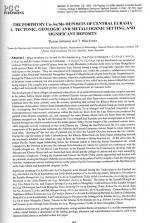Добрый день, Коллеги. Важное сообщение, просьба принять участие. Музей Ферсмана ищет помощь для реставрационных работ в помещении. Подробности по ссылке
The porphyry Cu-Au/Mo deposits of Central Eurasia: 1. tectonic, geologic & metallogenic setting and significant deposits
Major porphyry Cu-Au and Cu-Mo deposits (e.g. Oyu Tolgoi in Mongolia - >2.3 Gt @ 1.16% Cu, 0.35 g/t Au and Kal'makyr-Dalnee in Uzbekistan - >5 Gt @ 0.5% Cu, 0.4 g/t Au) are distributed over an interval of almost 5000 km across central Eurasia, from the Urals Mountains in Russia in the west, to Inner Mongolia in north-eastern China, to the east. These deposits were formed during a range of magmatic episodes from the Ordovician to the Jurassic. They are associated with magmatic arcs within the extensive subduction-accretion complex of the Altaid andTransbaikal-Mongolian Orogenic Collages that developed from the late Neoproterozoic, through the Palaeozoic to the Jurassic intra-cratonic extension, predominantly on the palaeo-Tethys Ocean margin of the proto- Asian continent, but also associated with the closure of two rifted back-arc basins behind that ocean facing margin. The complex now comprises collages of fragments of sedimentary basins, island arcs, accretionary wedges and tectonically bounded terranes composed of Neoproterozoic to Cenozoic rocks.
The development of these collages commenced when slivers of an earlier Proterozoic subduction complex accreted to the palaeo-Tethys Ocean margin of the combined Eastern Europe and Siberian cratons were rifted from the main cratonic mass. These slivers were the contiguous Karakum and Altai-Tarim micro-continents, which became separated from the main cratonic mass by oceanic spreading that created the Khanty-Mansi back arc basin. Subduction of the palaeo-Tethys Ocean beneath these micro-continents and the adjacent back-arc basin produced the overlapping late Neoproterozoic to early Palaeozoic Tuva-Mongol and Kipchak magmatic arcs. Contemporaneous intra-oceanic subduction within the back-arc basin from the Late Ordovician produced the parallel Urals-Zharma magmatic arc, and separated the main Khanty-Mansi back-arc basin from the inboard Sakmara marginal sea. By the Late Devonian the Tuva-Mongol and Kipchak arcs had amalgamated to form the Kazakh-Mongol arc which extended over the whole palaeo-Tethys Ocean margin of the combined cratonic mass, while magmatic activity continued on the Urals-Zharma arc. During the mid Palaeozoic the two main cratonic components of the proto-Asian continent, the Siberian and Eastern European cratons, began to rotate relative to each other, "drawing-in" the two sets of parallel arcs to form the Kazakh Orocline between the two cratons. During the Late Devonian to Early Carboniferous, the Khanty-Mansi back-arc basin began subducting beneath the oroclinally infolded outer island arc mass to form the Valerianov-Beltau-Kurama arc. At the same time the palaeo-Pacific Ocean began subducting below the Siberian craton to form the Sayan-Transbaikal arc, which expanded by the Permian to become the Selanga-Gobi-Khanka arc which for a period was continuous with the Kazakh-Mongol arc. By the Mid to Late Permian, as the Kazakh Orocline had continued to develop, both the Sakmara and Khanty-Mansi back-arc basins had been closed and the collage of cratons and arcs were sutured by accretionary complexes. During the Permian and Triassic the North China craton approached and docked with the continent, closing the Mongol-Okhotsk sea (an embayment on the palaeo-Pacific margin) to form the Mongolian Orocline. Subduction and arc building activity on the palaeo-Pacific Ocean margin continued to the Mid Mesozoic as the Indo-Sinian and Yanshanian orogenic cycles.
Significant porphyry Cu-Au/Mo and Au-Cu deposits were formed during the: Ordovician in the Kipchak arc (e.g. Bozshakol Cu-Au in Kazakhstan and Taldy Bulak porphyry Cu-Au in Kyrgyzstan); Silurian to Devonian in the Kazakh-Mongol arc (e.g. Nurkazgan Cu-Au in Kazakhstan; Taldy Bulak-Levoberezhny Au in Kyrgyzstan); Devonian in the Urals-Zharma arc (e.g. Yubileinoe Au-Cu in Russia); Devonian in the Kazakh-Mongol arc (e.g. Oyu Tolgoi Cu-Au, and Tsagaan Suvarga Cu-Au, both in Mongolia); Carboniferous in the Kazakh-Mongol arc (e.g. Kharmagtai Au-Cu in Mongolia, Tuwu-Yandong Cu-Au in Xinjiang, China; Koksai Cu-Au, Sayak skarn Cu-Au, Kounrad Cu-Au and the Aktogai Group of Cu-Au deposits, all in Kazakhstan); Carboniferous in the Valerianov-Beltau-Kurama arc (e.g. Kal 'makyr-Dalnee Cu-Au and Kochbulak epithermal Au, both in Uzbekistan; Benqala Cu-Au in Kazakhstan); Late Carboniferous to Permian in the Selanga-Gobi-Khanka arc (e.g. Duobaoshan Cu-Au in Inner Mongolia, China); Triassic in the Selanga-Gobi-Khanka arc (e.g. Erdenet Cu-Mo in Mongolia); and Jurassic in the Selanga-Gobi-Khanka arc (e.g. Wunugetushan Cu-Mo in Inner Mongolia, China).
In addition to the tectonic, geologic and metallogenic setting and distribution of porphyry Cu-Au/Mo mineralisation within central Eurasia, a description of the setting, geology, alteration and mineralisation recorded at each of the deposits listed above is included within this paper.




